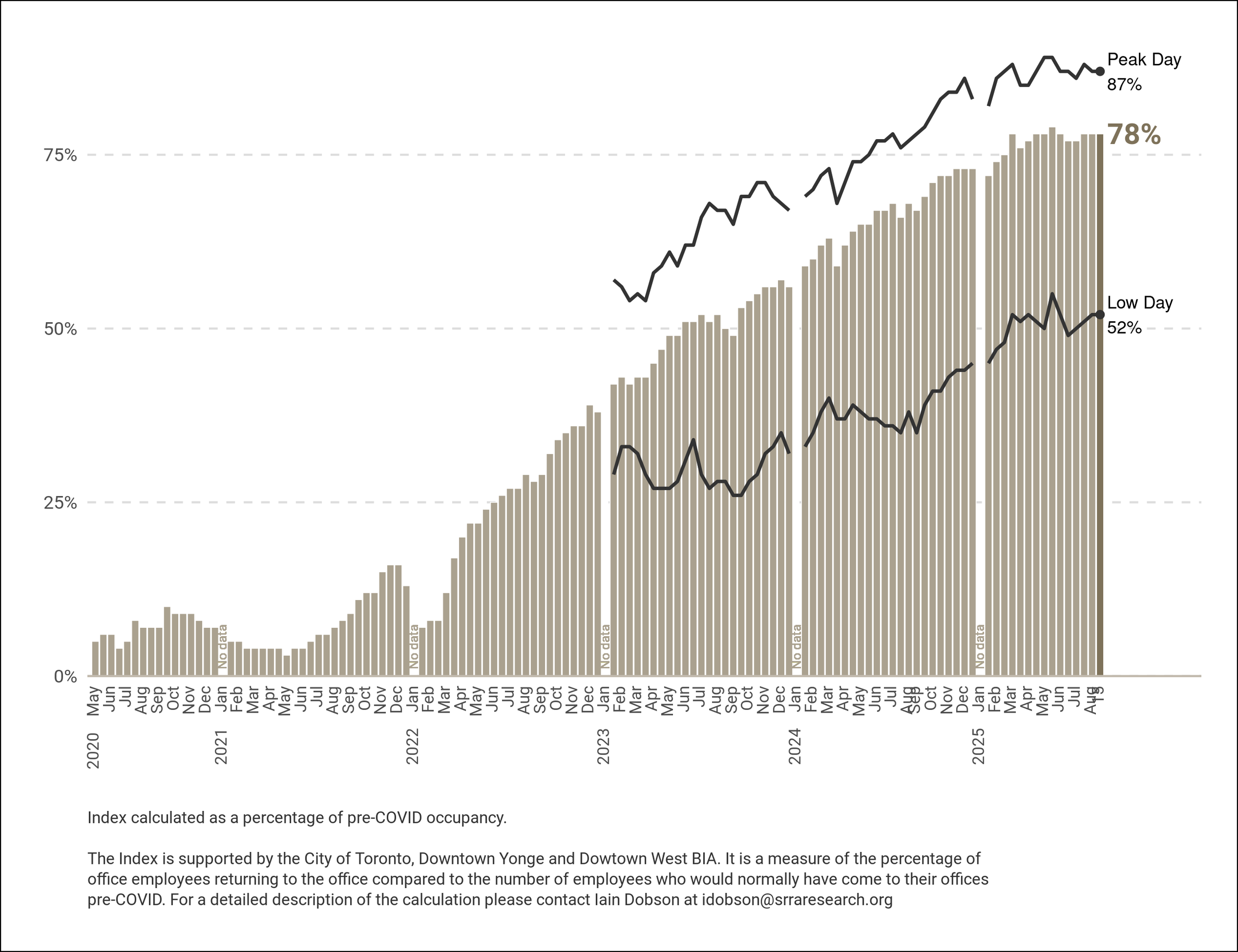Average weekly - 82%
Peak Day - Wednesday 92%
Low Day - Friday 52%
Prior to the COVID pandemic most companies did not track in-office attendance the way they are today. The assumption was that employees were in the office unless they were traveling on business or away on holidays or other well-established reasons for not being in the office. Planning an employee’s office use was simply a matter of allocating a desk for everyone. This has dramatically changed.
Hotelling, meaning employees do not have the same desk or office everyday, means that employees have to book one when they are in the office. Where a sizeable amount of remote work is permitted hotelling is becoming the norm. In theory this should work, but when employees choose to work remotely on Monday and Friday and return to in-office work in numbers on only Tuesday, Wednesday, and Thursday, hotelling its not working well.
We see the concentration of in-office work in the middle of the week as a serious problem for employers who are trying to maximize their office space. It is also an ongoing issue for transit planning, road congestion and retail sales in the downtown area. More on this in the next Index
Enjoy the ‘Articles of Interest’ below.
Your SRRA team
Links to Articles of Interest
Concerns for Future of Downtown Ottawa Influencing Federal Policy on Remote Work?
Participating in a Mayor’s Breakfast event in Ottawa in mid-December, the prime minister suggested that more detail on the government’s plan to bring federal workers back to the office is “imminent.” Noting Mayor Mark Sutcliffe’s well-known complaints about the negative impact on downtown caused by civil servants working from home, Mr Carney said, “I’m a huge fan of the public service. We need the public service at this critical time, and we need public servants to have all the tools, including offices and workspaces, which make their jobs as interesting, as impactful as possible.” This set off a round of push-back from union representatives, who criticized the prime minister for speaking without their permission.
Avison Young Points to Resurgence for Toronto’s Office Market
The Toronto office market is showing signs of positive activity according to a new report, although companies looking to sign new leases are selective, with “trophy” buildings getting the nod over B and C class buildings, which will “continue to struggle,” the report suggests.
Co-op Housing Making a Comeback Close to Kennedy Subway Station
A massive new co-op project with more than six hundred affordable units close to Kennedy subway station that benefits from the use of city-owned land was announced in December. “We’re back,” said Heather Tremain, executive director of the Co-operative Housing Federation of Toronto’s Development Society, which is a newly formed development arm of the federation, and aimed at leveraging its land trust and operational expertise to create more rental co-op projects. “We are talking to developers about a number of sites; we will put in a submission to Build Canada Homes. We think this is the kickoff,” she said. Federal funding for a co-op project in the city is the first in more than 30 years.
Commitment to Infrastructure Convinced Australian Fund to Open Office in Toronto
Decades after the Australian investor Macquarie tested the infrastructure investment waters in Canada, the Melbourne-based fund manager IFM is set to open an office in downtown Toronto, a decision fueled in part by the government’s high-profile commitment to infrastructure projects.
A Lesson in Economic Development Theory Supplied By American Universities
The power of anchoring economic stability – and increasingly, improving job prospects for graduates hit by the rise of AI –– with real estate investments from universities is being demonstrated in New York City, as colleges seek out well-located quality buildings to house new downtown campuses. The goal is to facilitate connections with employers but also to provide valuable exposure to life! “The classroom isn't just sitting in the classroom. You're in New York City,” a representative of Vanderbilt U noted. “If you're going to take an architecture class, it's not to sit in the classroom to take it. It's actually to experience it, breathe it, live it and understand it fully.”
TTC Acquires “Operational Control” Over Crosstown LRT
After waiting so many years for the Crosstown to enter service, commuters in Toronto can be forgiven for stifling a yawn over what should have been front page news: Metrolinx has completed its safety review and handed “operational control” over to the TTC, prompting speculation about a specific date in the new year for when the first paying passengers can be expected to board.
Widespread Concerns Over Finch LRT Lethargic Performance
With mainstream media rushing to criticize the newly opened Finch LRT over perceived “slowness,” concerns about TTC’s commitment to providing timely, rapid service are mounting. The chatter increased following a Globe and Mail editorial that put the new transit line literally on the national front page with a piece suggesting a jogger could outpace the train over the 10.3 km trip on Finch.
“The Occupancy Index is supported by the City of Toronto, Downtown Yonge BIA, and Downtown West BIA. It is a measure of the percentage of office employees returning to the office compared to the number of employees who would normally have come to their offices pre-COVID. For a detailed description of the calculation please contact Iain Dobson at [email protected],”





















